The Polycoated Cup Stock Market is estimated to be valued at USD 556.1 million in 2025 and is projected to reach USD 847.2 million by 2035, registering a compound annual growth rate (CAGR) of 4.3% over the forecast period.
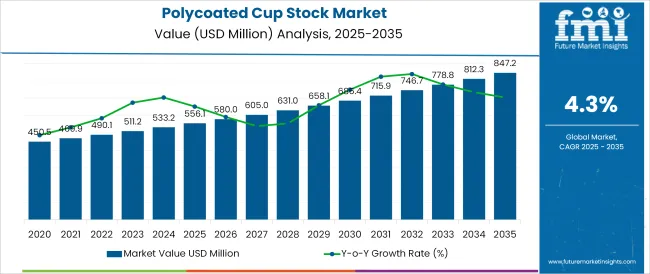
The polycoated cup stock market is witnessing consistent expansion, fueled by rising demand for disposable and semi-durable beverage packaging solutions across foodservice and industrial sectors. Regulatory pressures on plastic usage have shifted industry focus toward coated paperboard alternatives that maintain barrier properties while offering recyclability or compostability.
Advancements in aqueous and PLA coating technologies are enabling enhanced heat resistance and moisture sealing, making these materials suitable for hot and cold beverage applications. Investments in sustainable sourcing and FSC-certified base paperboard have gained prominence as brands aim to align packaging with environmental mandates.
With growing urban consumption patterns, particularly in on-the-go food and beverage services, manufacturers are scaling up high-speed forming capabilities and automated converting lines. As cup stock continues to be central to quick-service chains and vending systems, innovation in board weight optimization and improved surface printability is expected to support future growth. The market outlook remains robust, supported by strong end-user demand and evolving environmental compliance strategies.
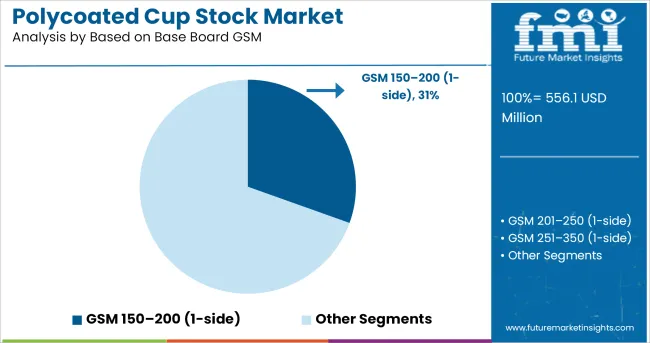
It has been observed that the GSM 150-200 (1-side) base board segment represents 30.50% of total revenue, establishing itself as the leading weight category in the market. This segment’s dominance is attributed to its optimal balance between rigidity, formability, and cost-efficiency.
The GSM range offers sufficient structural integrity for forming single-use cups without compromising machine runnability or sealing performance. The one-side polycoating configuration has been widely adopted due to its compatibility with both aqueous and heat-seal coating types, ensuring functionality in diverse foodservice environments.
Additionally, this weight range is preferred in automated cup-forming lines for its stability during processing and minimal wastage. The segment’s share reflects industry preference for reliable, scalable base substrates that align with volume-driven production requirements.

The cups application segment accounts for 34.80% of the overall market, positioning it as the most prominent use case for polycoated cup stock. This leadership is driven by sustained global demand for single-use beverage cups, particularly in the quick-service, office, and convenience retail channels.
The segment benefits from product lifecycle advantages such as ease of printing, moisture resistance, and temperature control-all essential for both hot and cold beverage applications. Consumer preference for hygienic, disposable containers and regulatory incentives for recyclable coated paper solutions have further supported growth.
Manufacturers have been focused on optimizing forming and die-cutting processes to meet this demand, with many investing in higher output lines specifically tailored for cup production. The combination of functionality, brand presentation, and market volume has reinforced the cups segment as a critical driver of polycoated cup stock consumption.
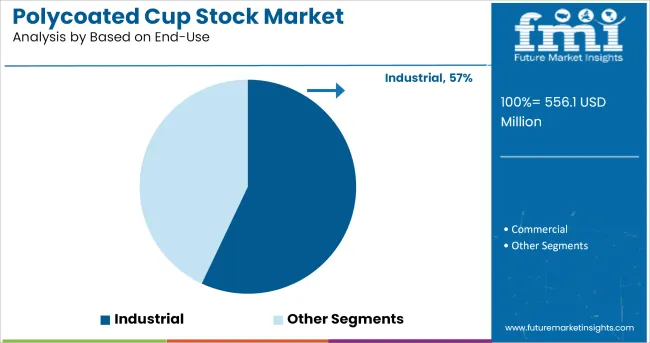
It is noted that the industrial segment contributes 57.0% of total revenue, making it the largest end-use category in the market. This dominance is a result of institutional and high-volume commercial consumption across sectors such as catering, workplace services, and contract packaging.
Polycoated board in this segment is widely used for bulk beverage services and automated dispensing systems, where consistency, durability, and temperature insulation are critical. The demand has been amplified by large-scale foodservice chains and facility management operations seeking dependable, cost-effective disposable cup solutions.
Additionally, industrial buyers prioritize compatibility with high-speed machinery, sustainability compliance, and minimal operational downtime. These performance-driven purchase considerations have cemented the industrial segment’s leadership, with ongoing growth fueled by expansion in institutional catering and contract manufacturing environments.
Food packaging such as food wrappers, paper cups, tray mats, grocery bags, containers, bowls, meal boxes, and fast-food containers are made from these polycoated cup stock paper. The polyethylene coating on various types of paper protects the product from moisture, oil, and grime while also providing heat selability. As a result, the product will have a longer shelf life and be more sanitary. The paper is extremely easy to print on.
Polycoated cup stock are highly hygienic, have low heat transfer, and are comfortable to hold beverages for longer periods of time.
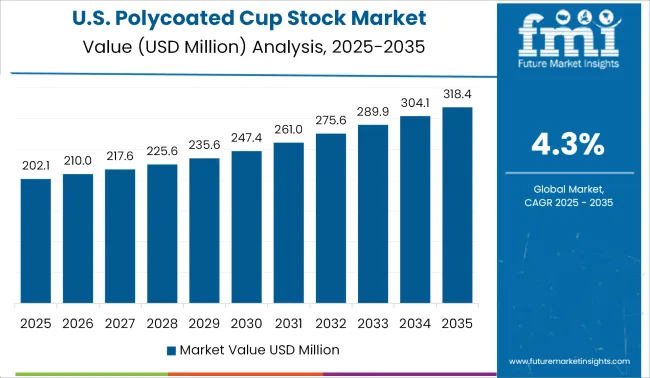
During the forecast period, the polycoated cup stock market in North America will grow at a significant rate. According to estimates from the paper and recycling industries, the United States and Canada utilise between 600,000 and 800,000 tons of single-use paper cups every year.
Hot and cold beverage paper cups are composed of solid bleached sulphate paperboard with a waterproofing poly coating. Paper cups are made up of a variety of materials, although most are made up of at least 90% paper fibre. Initially, clay or wax linings were employed for waterproofing; but, when polyethylene (PE) became more widely available, plastic linings and coatings became almost universally adopted.
Using PE and similar materials for lining improves performance while eliminating the unpleasant odours and tastes associated with clay and wax. All these properties are rising the demand for polycoated cup stock in USA and Canadian markets.

Europe is predicted to hold a significant market share of the polycoated cup stock market in the forecasted period. Although the cups are frequently lined with polyethylene coating to provide the required limited-term hot liquid, fatty acid, or oil-resistant barrier functionalities, along with maintaining cup integrity and preserve coffee aroma for the ultimate customer experience, the packaging uses sustainable and sometimes recycled wood fibre to make paperboard cupstock.
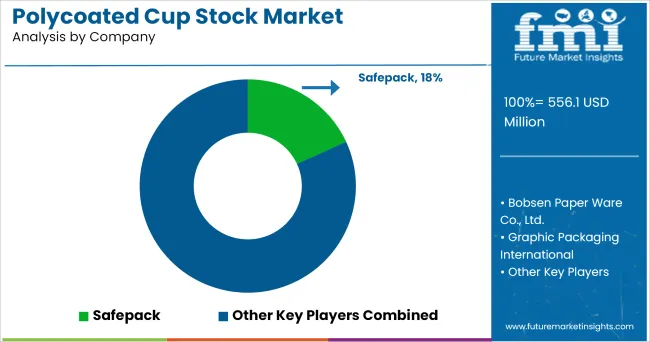
Some key manufacturers operating the business in the polycoated cup stock market globally include
Evergreen Packaging offers bio-based polyethylene, which is used to make a totally renewable cup stock. This cup stock was one of the first of its kind, and it was designed to be used both hot and cold.
The report is a compilation of first-hand information, qualitative and quantitative assessment by industry analysts, inputs from industry experts and industry participants across the value chain. The report provides an in-depth analysis of parent market trends, macro-economic indicators and governing factors along with market attractiveness as per segments. The report also maps the qualitative impact of various market factors on market segments and geographies.
The global polycoated cup stock market is estimated to be valued at USD 556.1 million in 2025.
The market size for the polycoated cup stock market is projected to reach USD 847.2 million by 2035.
The polycoated cup stock market is expected to grow at a 4.3% CAGR between 2025 and 2035.
The key product types in polycoated cup stock market are gsm 150–200 (1-side), gsm 201–250 (1-side), gsm 251–350 (1-side), gsm 160–200 (2-side), gsm 201–250 (2-side) and gsm 251–350 (2-side).
In terms of based on application, cups segment to command 34.8% share in the polycoated cup stock market in 2025.






Full Research Suite comprises of:
Market outlook & trends analysis
Interviews & case studies
Strategic recommendations
Vendor profiles & capabilities analysis
5-year forecasts
8 regions and 60+ country-level data splits
Market segment data splits
12 months of continuous data updates
DELIVERED AS:
PDF EXCEL ONLINE
Industry Share Analysis for Polycoated Cup Stock Companies
Polycoated Paper Packaging Market Size and Share Forecast Outlook 2025 to 2035
Polycoated Packaging Market Size and Share Forecast Outlook 2025 to 2035
Competitive Overview of Polycoated Paper Packaging Market Share
Market Share Insights of Polycoated Packaging Providers
Cupcake Box Market Size and Share Forecast Outlook 2025 to 2035
Cup Filling Machines Market Forecast and Outlook 2025 to 2035
Cupcake Liner Market Size and Share Forecast Outlook 2025 to 2035
Cupcake Containers Market Size and Share Forecast Outlook 2025 to 2035
Cupcake Wrappers Market Size and Share Forecast Outlook 2025 to 2035
Cup Holder Market Analysis - Size and Share Forecast Outlook 2025 to 2035
Cup Fill and Seal Machine Market by Automation Level from 2025 to 2035
Cup Carriers Market Size, Share & Trends 2025 to 2035
Cup Sleeves Market Growth - Demand, Trends & Forecast 2025 to 2035
Industry Share Analysis for Cup Fill and Seal Machine Companies
Market Share Breakdown of Cup Carrier Packaging Suppliers
Competitive Landscape of Cupcake Wrappers Manufacturers
Industry Share Analysis for Cupric Chloride Companies
Cupuacu Butter Market – Growth, Beauty Benefits & Market Demand
Cupcake Tray Machines Market

Thank you!
You will receive an email from our Business Development Manager. Please be sure to check your SPAM/JUNK folder too.
Chat With
MaRIA